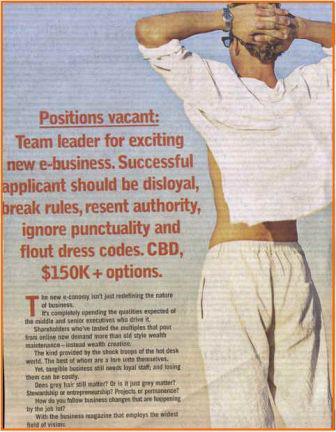In an early 2001 survey of more than 100 Australian companies, global management consulting and executive search firm AT Kearney found that ‘e-leaders’ are proving hard to find. Further, such people were more likely to share personality traits than university degrees.
The study suggested that successful e-leaders were likely to be paranoid, enjoy taking risks, readily admit to mistakes, and are obsessed with their customers.
Now 14+ years on in 2015, I still think these characteristics apply to social leaders, social CEOs, and those who want to provide leadership in a digitally disrupted world.
See also the transcript of my keynote at the Rotary Club of Sydney luncheon, 16th January 2001 titled “who will navigate today’s leaders through the e-commerce minefield” which expands on this survey.
Below is a real full-page advertisement that appeared in the Australian Financial Review in early 2001, during the height of the “dot-com boom”.
The research covers more than 100 Australian companies and looks at companies’ current readiness, competency and intentions to implement e-business across their operations. The survey respondents were all at senior executive level and able to comment on the organisation from a strategic viewpoint.
E-leaders come from a range of disciplines, with the majority having qualifications in finance/business (24 per cent), post-graduate studies (24 per cent), science or technology (23 per cent) or marketing (19 per cent). More importantly, they were seen as having similar personal attributes.
Characteristics of a good e-leader
Customer obsessed
Preoccupied with how his/her company can better serve the customer. Talks or communicates with customers on a daily basis – asks questions and listens without judging.
Paranoid
Challenges the status quo. Continually trying to outsmart and second think competitors and anticipate customers’ needs. Strives to understand how new technology can better serve customers.
Risk-taker
Comfortable making decisions without all the information. The online world is changing too fast to procrastinate.
Has ‘bandwidth separation’ anxiety
Cannot be more than five minutes away from a telephone, pager or Internet connection
Admits mistakes
Shares bad news quickly and encourages others to do the same. Experiments, tries many things, makes mistakes, learns, moves on, is not penalised.
Evangelising
Can’t help but spread the word. Selling what isn’t there to employees, customers, shareholders and the board. Must be able to visualise a future very different to current reality and be passionate about it.
Thrives on ambiguity
Always has the helicopter view and is very comfortable with fluidity. If you don’t have a restructure every second week these people get nervous.
Brutally frank
To themselves and others. Realises own skill shortcomings and compensates by teaming with the right people. Outstanding project manager.
Results orientated
Always looking for faster ways to achieve the desired outcome. “I want it now, I want it perfect, and I want it for free”.
Credible
Is respected in all business divisions and functions.
“Only 34 per cent of Australian companies have a dedicated e-business person working on e-business issues, with many having to go outside their industry sector and/or outside the country to find suitable individuals,” says Graeme Cowan, Vice President at A.T. Kearney Executive Search, who commissioned the research.
“Despite the relatively good remuneration ($150,000 plus packages), a significant number of companies surveyed said they were finding it difficult to acquire people with e-commerce skills in strategy formulation,” he said.
“In order for companies to move on in today’s environment, they need strong e-leadership, significant mind-shift and organisational change.”
Better understanding e-business
Australian companies have been undertaking some unusual methods to improve their leaders’ understanding of e-business. The following are some examples of action taken:
- Creating new e-business divisions – often reporting directly to the CEO to formulate strategy and educate other divisional leaders.
- Appointing young e-mentors – to help older “non connected” leaders understand the implications of the digital economy. Jack Welch at GE has instituted this globally.
- Unlimited home access to the Internet – encourage exploration mentality.
- Bookmark successful e-business sites on Intranet.
- Insist leaders buy items/services regularly over the Internet.
- Distribute e-business related books.
- Create an e-business vision for the leadership team.
- Study tours to the US for leadership team.
- Link annual bonus to achieving e-business milestones.
- Targeted e-business training.
- Appoint a human resources person 100 per cent dedicated to anticipating skills required from 1-3 years out and plan how to acquire them.
About the survey
The total company revenue of surveyed companies was $254 billion with sizes varying from $4M to $10 billion-plus. The employee numbers range of surveyed companies was from under 100 to over 20,000, with a total of 685,000 staff represented. A broad mix of public, private and multinational ownership was used and all major industry segments were presented.
The survey aimed to obtain an organisational snapshot of the following issues:
The company and leaders
- What priority does e-business strategy have for the executive team?
- How many senior executives understand e-business potential?
- How ready is the organisation to implement its e-business strategy?
The e-business drivers
- Who drives e-business in the organisation?
- Where do they sit functionally?
- What are their background qualifications, salary packages?
The barriers and gaps
- What e-business skills are in short supply?
- What strategies are being used to acquire the skills and people?

